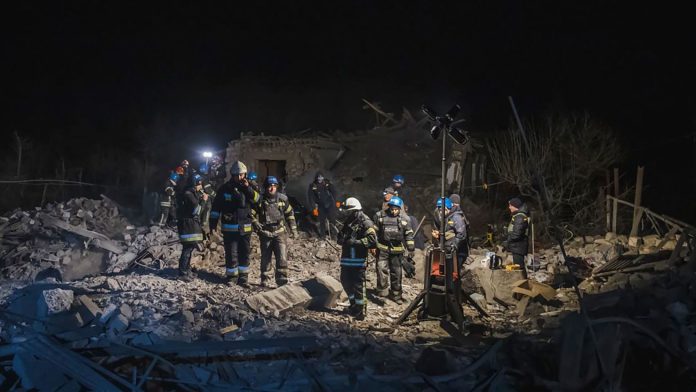As high-level peace talks stir headlines in Washington and Moscow, the reality on Ukraine’s northern front tells a different story. Deep in the mud, under fire, and underground, battlefield medics like Stork and his team carry on a relentless fight to keep soldiers alive—while diplomacy remains a distant murmur.
Amid Peace Talks, Ukraine’s Frontline Medics Battle On with Little Hope of Truce
When I first met Stork, he was cutting off a soldier’s foot. The second time, he was dressing a shin so shattered it held no bone. And the third—this April—he was huddled underground, watching surveillance cameras for signs of life or death.
Sunlight rarely finds him. Stork lives and works in the basement of a former family home, now transformed into a field hospital near Ukraine’s northern border with Russia. From this hidden outpost, his job is as simple as it is brutal: stabilize the wounded enough to get them to the next hospital.
He treats casualties from Vovchansk, a Ukrainian town mere kilometres from Russia’s Belgorod region. It’s an area where President Volodymyr Zelensky recently acknowledged active Ukrainian military operations.
Yet, Stork’s world feels galaxies away from the polished rooms of global diplomacy—in the Oval Office, the corridors of Brussels, or Riyadh’s luxury hotels—where peace talks have unfolded. While Moscow has spoken of a potential ceasefire, its military has not slowed. And with a possible Trump return to the White House, fears rise that U.S. support could be withheld unless Ukraine accepts an unfavourable peace.
But none of that reaches the basement.
“I don’t feel comfortable with the US anymore. Not since the elections,” Stork says, sorting patient records after a shift spent cleaning burns and disinfecting wounds.
Oleh, the lead surgeon, scoffs at the notion of peace. “Peace? What peace?” he says while petting his dog. “Putin hasn’t changed his invasion plans.”
Last autumn, Oleh made the call to move the operating theatre closer to the front. It was taking too long to get the wounded to safety. He ordered a new setup underground.
This decision came as Donald Trump declared he could end the war in 24 hours. Meanwhile, President Zelensky unveiled his 10-point victory plan. Neither plan feels tangible to Mykola, the team’s anaesthetist.
“Our president said we’d liberate most of the occupied territories in 2023,” Mykola says. “And yet, here we are.”
From civilian hospitals in Kharkiv to war bunkers heated by wood stoves, Oleh and his team now serve soldiers instead of patients.
Rest is short-lived. “Get up! We’ve got work!” someone shouts. Paramedics spring from mattresses. Soldiers arrive in a medevac vehicle caged in anti-drone netting. One man, Andrii, lies motionless—his body burned raw from a trench fire. Another soldier, Serhii, stares silently at his blistered hands, a crucifix resting on his chest.
Soldiers say it’s not the enemy that terrifies them. It’s the unknown.
Mykhailo, an artilleryman, waits underground beside a Soviet-era howitzer. An American flag hangs on his vest—he shrugs, saying it came with the backpack. Above him, rats scurry in the ceiling.
His commander, Anatoliy, examines a laptop feed showing trees and mud—he sees enemy tracks, not branches. His unit, one of eight redeployed to Ukraine’s northeast in May 2024, has fought here for over a year. Russia wanted Vovchansk, to push toward Kharkiv and pummel Ukraine’s second-largest city.
They didn’t succeed.
Vovchansk, now barely clinging to life, sits five kilometres from the border. Once home to 20,000, it’s now a ruin. And though the front is quiet for now, Anatoliy warns it’s not the time to attack. “Better to keep defending,” he says. “Attacking costs too many lives.”
Still, Ukraine has opened a new front near Belgorod. Zelensky justified it bluntly: “The war must return to where it came from.”
In response, Russia announced a new wave of mobilization—160,000 troops. But as Anatoliy points out, “Since New Year, most of their assaults are on foot. Armoured vehicles? You barely see them. They’re just sent to die.”
He reviews drone footage of Vovchansk’s wreckage. Despite U.S. weapons aid, he hasn’t seen much of it.
“I know they’ve sent a lot of weapons. But I’ve never seen any of it. Here, we fight with Soviet equipment.”
Still, the line holds.
The future remains uncertain. The only thing the soldiers believe is that any ceasefire will be fleeting. Even as a new Ukrainian delegation prepares to visit Washington, the war goes on.
Serhii, now swaddled in clean bandages, silently gestures for a cigarette before his second evacuation begins. His name is the only word he’s spoken. The bumpy, muddy track and thick fog offer some concealment as his medevac rolls out.
Stork checks the catheter and shuts the door. The soldier is asleep within minutes, lulled by exhaustion and morphine. Everyone inside knows that evacuating in daylight is dangerous. But until both sides agree to silence their guns, they have no other option.
This is the reality of war in Ukraine.
Here, peace remains just a rumour.
#UkraineWar #FrontlineMedics #Vovchansk #RussiaUkraineConflict #FieldHospital #PeaceTalks #MoscowVsKyiv


